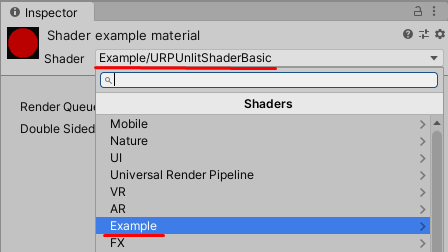7.6 KiB
URP unlit basic shader
This example shows a basic URP-compatible shader. This shader fills the mesh shape with a color predefined in the shader code.
To see the shader in action, copy and paste the following ShaderLab code into the Shader asset.
// This shader fills the mesh shape with a color predefined in the code.
Shader "Example/URPUnlitShaderBasic"
{
// The properties block of the Unity shader. In this example this block is empty
// because the output color is predefined in the fragment shader code.
Properties
{ }
// The SubShader block containing the Shader code.
SubShader
{
// SubShader Tags define when and under which conditions a SubShader block or
// a pass is executed.
Tags { "RenderType" = "Opaque" "RenderPipeline" = "UniversalPipeline" }
Pass
{
// The HLSL code block. Unity SRP uses the HLSL language.
HLSLPROGRAM
// This line defines the name of the vertex shader.
#pragma vertex vert
// This line defines the name of the fragment shader.
#pragma fragment frag
// The Core.hlsl file contains definitions of frequently used HLSL
// macros and functions, and also contains #include references to other
// HLSL files (for example, Common.hlsl, SpaceTransforms.hlsl, etc.).
#include "Packages/com.unity.render-pipelines.universal/ShaderLibrary/Core.hlsl"
// The structure definition defines which variables it contains.
// This example uses the Attributes structure as an input structure in
// the vertex shader.
struct Attributes
{
// The positionOS variable contains the vertex positions in object
// space.
float4 positionOS : POSITION;
};
struct Varyings
{
// The positions in this struct must have the SV_POSITION semantic.
float4 positionHCS : SV_POSITION;
};
// The vertex shader definition with properties defined in the Varyings
// structure. The type of the vert function must match the type (struct)
// that it returns.
Varyings vert(Attributes IN)
{
// Declaring the output object (OUT) with the Varyings struct.
Varyings OUT;
// The TransformObjectToHClip function transforms vertex positions
// from object space to homogenous clip space.
OUT.positionHCS = TransformObjectToHClip(IN.positionOS.xyz);
// Returning the output.
return OUT;
}
// The fragment shader definition.
half4 frag() : SV_Target
{
// Defining the color variable and returning it.
half4 customColor = half4(0.5, 0, 0, 1);
return customColor;
}
ENDHLSL
}
}
}
The fragment shader colors the GameObject dark red (RGB value (0.5, 0, 0)).
The following section introduces you to the structure of this basic Unity shader.
Basic ShaderLab structure
Unity shaders are written in a Unity-specific language called ShaderLab.
The Unity shader in this example has the following blocks:
Shader block
ShaderLab code starts with the Shader declaration.
Shader "Example/URPUnlitShaderBasic"
The path in this declaration determines the display name and location of the Unity shader in the Shader menu on a Material. The method Shader.Find also uses this path.
Properties block
The Properties block contains the declarations of properties that users can set in the Inspector window on a Material.
In this example, the Properties block is empty, because this Unity shader does not expose any Material properties that a user can define.
SubShader block
A Unity shader source file contains one or more SubShader blocks. When rendering a mesh, Unity selects the first SubShader that is compatible with the GPU on the target device.
A SubShader block can optionally contain a SubShader Tags block. Use the Tags keyword to declare a SubShader Tags block.
Tags { "RenderType" = "Opaque" "RenderPipeline" = "UniversalPipeline" }
A SubShader Tag with a name of RenderPipeline tells Unity which render pipelines to use this SubShader with, and the value of UniversalPipeline indicates that Unity should use this SubShader with URP.
To execute the same shader in different render pipelines, create multiple SubShader blocks with different RenderPipeline tag values. To execute a SubShader block in HDRP, set the RenderPipeline tag to HDRenderPipeline, to execute it in the Built-in Render Pipeline, set RenderPipeline to an empty value.
For more information on SubShader Tags, see ShaderLab: SubShader Tags.
Pass block
In this example, there is one Pass block that contains the HLSL program code. For more information on Pass blocks, see ShaderLab: Pass.
A Pass block can optionally contain a Pass tags block. For more information, see URP ShaderLab Pass tags.
HLSLPROGRAM block
This block contains the HLSL program code.
NOTE: HLSL language is the preferred language for URP shaders.
NOTE: URP supports the CG language. If you add the CGPROGRAM/ENDCGPROGRAM block in a shader, Unity includes shaders from the Built-in Render Pipeline library automatically. If you include shaders from the SRP shader library, some SRP shader macros and functions might conflict with the Built-in Render Pipeline shader functions. Shaders with the CGPROGRAM block are not SRP Batcher compatible.
This block contains the #include declaration with the reference to the Core.hlsl file.
#include "Packages/com.unity.render-pipelines.universal/ShaderLibrary/Core.hlsl"
The Core.hlsl file contains definitions of frequently used HLSL macros and functions, and also contains #include references to other HLSL files (for example, Common.hlsl and SpaceTransforms.hlsl).
For example, the vertex shader in the HLSL code uses the TransformObjectToHClip function from the SpaceTransforms.hlsl file. The function transforms vertex positions from object space to homogenous space:
Varyings vert(Attributes IN)
{
Varyings OUT;
OUT.positionHCS = TransformObjectToHClip(IN.positionOS.xyz);
return OUT;
}
The fragment shader in this basic HLSL code outputs the single color predefined in the code:
half4 frag() : SV_Target
{
half4 customColor;
customColor = half4(0.5, 0, 0, 1);
return customColor;
}
Section URP unlit shader with color input shows how to add the editable color property in the Inspector window on the Material.

